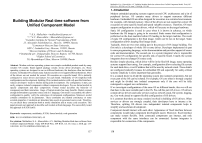Building modular real-time software from unified component model
Автор: Mallachiev K.A., Khoroshilov A.V.
Журнал: Труды Института системного программирования РАН @trudy-isp-ran
Статья в выпуске: 3 т.30, 2018 года.
Бесплатный доступ
Modern real-time operating systems are complex embedded product made by many vendors: OS vendor, board support package vendor, device driver developers, etc. These operating systems are designed to run on different hardware; the hardware often has limited memory. Embedded OS contains many features and drivers to support different hardware. Most of the drivers are not needed for correct OS execution on a specific board. OS is statically configured to select drivers and features for each board. Modularity of OS simplifies both configuration and development. Splitting OS to isolated modules with well-specified interfaces reduces developers’ needs to interact during joint development. The configurator, in turn, can easily compose isolated components without component developers. We use formal models to specify components and their composition. Formal model describes the behavior of components and their interaction. Usage of formal models has many benefits. Models contain enough information to generate source code in C language. Our model is executable; this allows configurator to quickly verify the correctness of component configurations. Moreover, model contains constraints on its parameters. These constraints are internal consistency or some external properties. Constraints are translated into asserts in generated source code. Therefore, we can check these constraints both at model simulation and at source code execution. This paper presents our approach to describe such models at Scala language. We successfully tested the approach in RTOS JetOS.
Components, modularity, rtos, formal models, code generation
Короткий адрес: https://sciup.org/14916534
IDR: 14916534 | DOI: 10.15514/ISPRAS-2018-30(3)-10
Список литературы Building modular real-time software from unified component model
- K.M. Mallachiev, N.V. Pakulin, and A.V. Khoroshilov. Design and architecture of real-time operating system. Trudy ISP RAN/Proc. ISP RAS, vol. 28, no. 2, 2016, pp. 181-192 DOI: 10.15514/ISPRAS-2016-28(2)-12
- J. Siegel and D. Frantz. CORBA 3 fundamentals and programming. John Wiley & Sons New York, NY, USA, 2000, vol. 2.
- N. Wang, D. C. Schmidt, and C. O’Ryan. Overview of the corba component model. In Component-Based Software Engineering. Addison-Wesley Longman Publishing Co., Inc., 2001, pp. 557-571.
- A. Gefflaut, T. Jaeger, Y. Park, J. Liedtke, K. J. Elphinstone, V. Uhlig, J. E. Tidswell, L. Deller, and L. Reuther. The sawmill multiserver approach. In Proceedings of the 9th workshop on ACM SIGOPS European workshop: beyond the PC: new challenges for the operating system, 2000, pp. 109-114.
- I. Boule, M. Gien, and M. Guillemont. Chorus distributed operating systems. Computing Systems, vol. 1, no. 4, 1988, pp. 305-370.
- B. Ford, G. Back, G. Benson, J. Lepreau, A. Lin, and O. Shivers. The flux oskit: A substrate for kernel and language research. ACM SIGOPS Operating Systems Review, vol. 31, no. 5, 1997, pp. 38-51.
- A. Massa, Embedded software development with eCos. Prentice Hall Professional Technical Reference, 2002.
- J.-P. Fassino, J.-B. Stefani, J. L. Lawall, and G. Muller. Think: A software framework for component-based operating system kernels. In Proceedings of the USENIX Annual Technical Conference, General Track, 2002, pp. 73-86.
- F. Loiret, J. Navas, J.-P. Babau, and O. Lobry. Component-based real-time operating system for embedded applications. In Proceedings of the International Symposium on Component-Based Software Engineering. Springer, 2009, pp. 209-226.
- K. Mallachiev, N. Pakulin, A. Khoroshilov, and D. Buzdalov. Using modularization in embedded OS. Trudy ISP RAN/Proc. ISP RAS, vol. 29, issue. 4, 2017, pp. 283-294 DOI: 10.15514/ISPRAS-2017-29(4)-19


